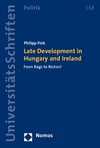Zusammenfassung
Irland und Ungarn verfolgen eine Entwicklungsstrategie, die in bewusster Abhängigkeit von Globalisierungsprozessen in Form von ausländischen Direktinvestitionen steht und sich als Paradigma in der Peripherie durchgesetzt hat. Doch dieser Entwicklungspfad hat zu einer ungleichen und abhängigen Entwicklung geführt. Dies ist laut dem Autor das Resultat des mangelnden Gestaltungswillens beider Staaten, für einen gleichgewichtigen Wachstumsprozess zu sorgen. Die historische Analyse zeigt, dass eine auf ausländische Firmen fußende Entwicklungsstrategie nicht ausreicht, um traditionelle Peripheralität zu überwinden. Der Autor fordert eine Reform des Entwicklungsparadigmas, um eine gleichgewichtige Entwicklung zu ermöglichen.
Abstract
Irland und Ungarn verfolgen eine Entwicklungsstrategie, die in bewusster Abhängigkeit von Globalisierungsprozessen in Form von ausländischen Direktinvestitionen steht und sich als Paradigma in der Peripherie durchgesetzt hat. Doch dieser Entwicklungspfad hat zu einer ungleichen und abhängigen Entwicklung geführt. Dies ist laut dem Autor das Resultat des mangelnden Gestaltungswillens beider Staaten, für einen gleichgewichtigen Wachstumsprozess zu sorgen. Die historische Analyse zeigt, dass eine auf ausländische Firmen fußende Entwicklungsstrategie nicht ausreicht, um traditionelle Peripheralität zu überwinden. Der Autor fordert eine Reform des Entwicklungsparadigmas, um eine gleichgewichtige Entwicklung zu ermöglichen.
- 13–14 List of Tables 13–14
- 15–16 Abbreviations 15–16
- 17–27 Introduction 17–27
- 43–46 1.2.2 Emigration 43–46
- 47–51 1.4.1 Hungary 47–51
- 51–55 1.4.2 Ireland 51–55
- 109–115 3.2 Preconditions 109–115
- 156–160 4.1 Dualism 156–160
- 156–159 4.1.1 Industrial Dualism 156–159
- 159–160 4.1.2 Social Dichotomy 159–160
- 166–169 4.2.2 Linkages 166–169
- 169–171 4.2.3 Indigenous Firms 169–171
- 201–207 4.4.2 Linkages 201–207
- 253–278 Bibliography 253–278

